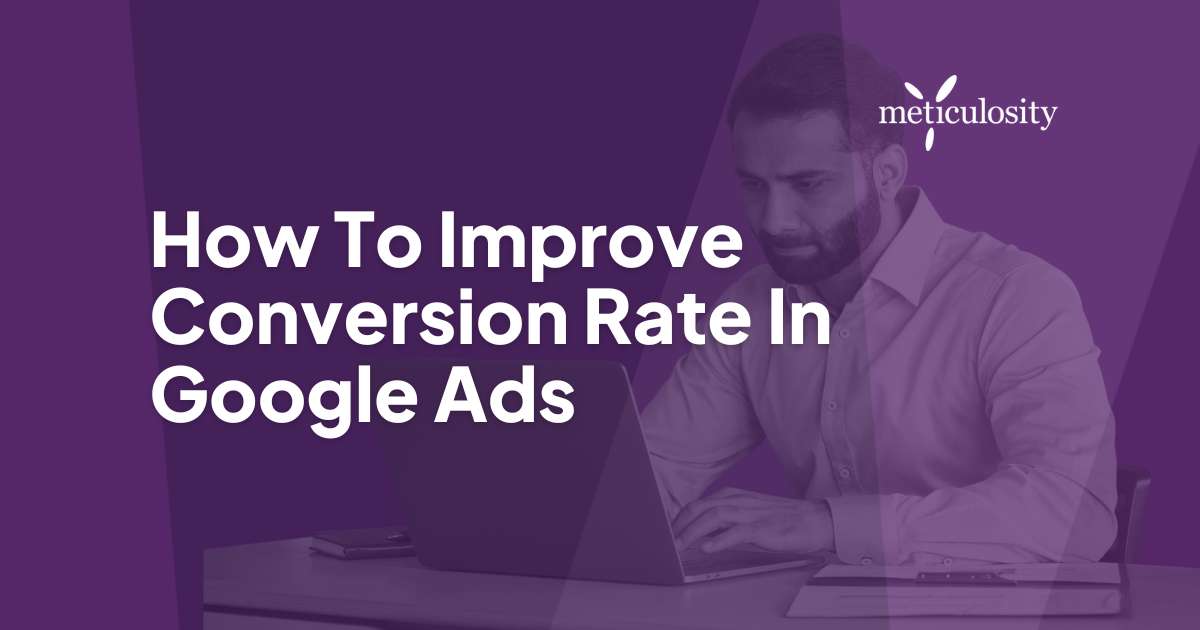Do daunting Google Ad metrics have you questioning your marketing abilities? Believe me, we all take our turn at this challenging crossroads. After wrapping my mind around hundreds of thriving ad campaigns, I've discovered a gold mine of tactics to give your conversion rates a significant boost.
In this blog post, we're going to delve into these insights together and soon enough, you'll be watching the transformation unfold right on your Google Ads dashboard!
Understanding the Importance of Conversion Rate in Google Ads
Conversion rate is a crucial metric in Google Ads, as it directly impacts the success of your advertising efforts.
Defining conversion rate and its impact on advertising success
Conversion rate is about counting how many people do what you want after seeing your ad. It's like a score that tells you how well your ad is working. You find it by looking at the number of times people did something because of your ad and dividing it by the number of times someone clicked on your ad.
If lots of people who click on your ads end up doing what you want them to do, that's good! It means more customers for less money spent on ads. This makes conversion rate very important in Google Ads.
A high rate means a lot of wins from the same cost. Every business or marketer wants this!
Strategies for Enhancing Conversion Rate in Google Ads
To improve your conversion rate in Google Ads, focus on optimizing the customer journey, crafting compelling ad copy and headlines, creating custom landing pages, targeting relevant keywords, improving the landing page experience, and incorporating pricing in ad copy.
These strategies will help you attract more qualified leads and increase conversions. Read on to learn more about each strategy and how to implement them effectively.
Optimizing the customer journey
Improving the customer journey is key to better conversion rates. Start by mapping out your client's path from first click to purchase. Find and fix any bumps along the way. A smooth ride keeps more visitors on your site, leading to more sales.
Crafting compelling ad copy and headlines
Great ad copy pulls in clicks. It uses strong words and stirs feelings. If your ads look boring, people will ignore them. Make your ads fun and full of life to get more clicks.
Headlines matter as much as the ad copy. They are what people see first when they spot your ad in search results. Use good words and phrases that stick in a person's mind right away.

A dull headline will make someone pass by your offer without a second glance. A catchy headline can cause that same person to stop, read, and click on your offer instead.
Creating custom landing pages
Creating custom landing pages is a highly effective strategy for improving conversion rates in Google Ads. Here are some key tips to keep in mind:
- Ensure your landing page aligns with your ad: Make sure the messaging and visuals on your landing page are consistent with the ad that brought users there. This helps maintain relevance and reduces bounce rates.
- Optimize for user experience: Design your landing page to be user-friendly and easy to navigate. Use clear headings, subheadings, and bullet points to convey information. Also, include a prominent call-to-action (CTA) that stands out and encourages users to take the desired action.
- Segment your audience: If you have different target audiences, consider creating custom landing pages for each segment. Tailor the content, visuals, and offers on these pages to appeal specifically to each group's needs and preferences.
- Test different variations: Experiment with different layouts, images, headlines, and CTAs on your landing pages. Use A/B testing to compare the performance of different versions and identify which elements drive higher conversions.
- Optimize loading speed: Slow-loading landing pages can lead to high bounce rates. Optimize image sizes, minimize redirects, and use caching techniques to ensure fast loading times.
Targeting relevant keywords
When it comes to improving conversion rates in Google Ads, targeting relevant keywords is key. Here are some strategies that can help:
- Use specific keywords: By focusing on specific keywords related to your products or services, you can attract more qualified leads and increase conversion rates.
- Consider search intent: Understand the intent behind different search terms and tailor your keywords accordingly. This ensures that your ads are shown to people who are more likely to convert.
- Exclude irrelevant search terms: Use negative keywords to prevent your ads from appearing for searches that are not relevant to your business. This helps in attracting the right audience and improves conversion rates.

- Refine keyword match types: Experiment with different match types (broad match, phrase match, exact match) to gain better control over which searches trigger your ads. This allows you to target more specific queries and increase conversions.
- Monitor keyword performance: Regularly review performance metrics like click-through rate (CTR) and conversion rate for each keyword. This data can help you identify underperforming keywords that may need optimization or replacement.
Utilizing Tools and Analytics for Conversion Rate Measurement
To effectively measure conversion rates, it's crucial to utilize tools like Google Analytics and implement conversion tracking. These tools provide valuable insights into user behavior, allowing businesses to make data-driven decisions for optimizing their Google Ads campaigns.
A/B testing can also be employed to experiment with different variations and determine which strategies yield the highest conversions.
Leveraging Google Analytics
To improve conversion rates in Google Ads, it's important to leverage the power of Google Analytics. By linking your Google AdWords and Analytics accounts, you can gain valuable insights into your ad performance.
With Google Analytics, you can track metrics like traffic sources, landing pages, bounce rate, and conversion rate. This data can help you make informed decisions about optimizing your campaigns and improving your conversion rates.
Implementing conversion tracking
Conversion tracking is a crucial step in improving your Google Ads conversion rate. Here are some key steps to implement conversion tracking effectively:
- Set up conversion tracking: Start by creating a Google Ads account and select the "Tools & Settings" tab. From there, choose "Conversions" and click on the "+" button to create a new conversion action.
- Choose your conversion action type: You can track various actions such as purchases, form submissions, phone calls, or website visits. Select the action that aligns with your business goals.
- Configure your settings: Provide details about your conversion action, including its name, value (if applicable), count type (unique or all), and attribution model (how conversions are attributed to ad interactions).
- Add the tracking code: Once you've configured the settings, you'll receive a small snippet of code that needs to be added to the webpage where the conversion occurs.
- Test your tracking setup: It's important to ensure that the tracking code is implemented correctly. Use Google's Tag Assistant or Chrome extension to verify that the code is working as intended.
- Optimize conversions in Google Ads: Once you have set up conversion tracking, you can use this data to optimize your Google Ads campaigns further. Analyze which keywords, ads, or landing pages are generating the most conversions and make adjustments accordingly.
Conducting A/B testing
To improve your conversion rate in Google Ads, conducting A/B testing is crucial. Here are some key points to consider:
- Create multiple variants: Develop different versions of your ads or landing pages.
- Randomly present variants: Show each version randomly to users to gather data on their performance.
- Compare performance: Analyze the results of each variant to determine which one leads to higher conversions.
- Test various elements: Experiment with different headlines, ad copy, images, and calls-to-action (CTAs) to see what resonates best with your audience.
- Measure statistically significant impact: Look for significant differences in conversion rates between the variants before making any conclusions.
- Optimize based on data: Use the insights gained from A/B testing to refine and improve your ads or landing pages.
Tracking and Analyzing Conversion Data
Tracking and analyzing conversion data is crucial for understanding the success of your Google Ads campaigns. By monitoring conversion rates and analyzing conversion funnels, you can identify areas for improvement and make data-driven optimizations to increase your conversion rate.

Utilize tools like Google Analytics, implement conversion tracking, and conduct A/B testing to gather valuable insights. Making informed decisions based on this data will help you continuously optimize your campaigns and improve your overall performance.
Continuous Optimization for Improved Conversion Rate
Continuously review and adjust your Google Ads campaigns to ensure ongoing optimization for improved conversion rates. Regularly testing and experimenting with different ad copy, designs, and tactics will help you identify areas for improvement and make data-driven decisions that drive better results.
Regularly reviewing and adjusting campaigns is crucial for improving conversion rates in Google Ads. Here are some important steps to take:
- Analyze campaign performance data: Look at key metrics such as click-through rate (CTR), conversion rate, and cost per conversion to identify areas for improvement.
- Test different ad variations: Experiment with different headlines, ad copy, and images to see which ones resonate best with your target audience.
- Refine keyword targeting: Continuously monitor the performance of your keywords and make adjustments as needed. Add negative keywords to exclude irrelevant searches.
- Optimize landing pages: Ensure that your landing pages are user-friendly, have clear calls-to-action, and provide relevant information to visitors.
- Adjust bids and budgets: Regularly review your bidding strategy and adjust bids based on performance data. Allocate budget to high-performing campaigns and adjust or pause underperforming ones.
- Stay updated with industry trends: Keep an eye on changes in your industry and adapt your campaigns accordingly. This includes staying informed about new keywords, competitors, and market trends that could impact your conversions.
Conclusion,
In conclusion, understanding the importance of conversion rate in Google Ads is paramount for the success of your advertising efforts. Conversion rate serves as a vital metric that directly influences the effectiveness and efficiency of your ad campaigns.
If you have want to start improving your conversion rates in Google Ads, talk to our experts today to guide you!







